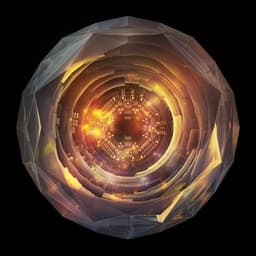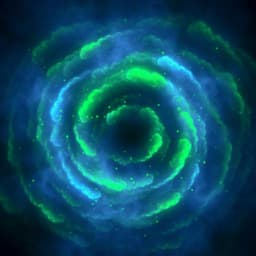
Physics
Bose-Einstein condensation of photons in a vertical-cavity surface-emitting laser
M. Pieczarka, M. Gębski, et al.
This groundbreaking research reveals the phenomenon of Bose-Einstein condensation (BEC) of photons in a vertical-cavity surface-emitting laser (VCSEL). Observations showcased a BEC at critical phase-space density, while demonstrating insights into the superfluid physics of interacting photons, thanks to the work of Maciej Pieczarka, Marcin Gębski, Aleksandra N. Piasecka, James A. Lott, Axel Pelster, Michał Wasiak, and Tomasz Czyszanowski.
~3 min • Beginner • English
Introduction
The study investigates whether photons in a semiconductor laser can undergo Bose-Einstein condensation (BEC), a macroscopic occupation of the ground state predicted by Einstein for bosons and observed in ultra-cold atomic gases. Because the critical temperature scales inversely with particle mass, massless photons typically do not condense in thermal equilibrium where particle number is not conserved and the chemical potential vanishes. Prior work realized photon BEC in dye-filled microcavities and fiber cavities, revealing equilibrium and driven-dissipative behaviors but with limited, slow nonlinearities that hinder superfluid studies. The research question is whether a technologically relevant semiconductor laser platform, specifically a large-aperture electrically driven VCSEL at room temperature, can support photon BEC with thermalized spectra and critical behavior distinct from standard non-equilibrium lasing, and whether its thermodynamics follow those of a 2D Bose gas. The purpose is to demonstrate photon BEC in such a VCSEL, identify conditions (cavity–gain detuning) favoring BEC versus lasing, and extract thermodynamic parameters (effective temperature, chemical potential, phase-space density) to test the equation of state (EOS). The significance lies in enabling potential room-temperature superfluid photon physics with fast semiconductor nonlinearities and practical single-mode high-power emission from large-aperture devices.
Literature Review
The work builds on foundational BEC theory and experiments in dilute atomic gases and extends to quasiparticles with small effective masses (magnons, excitons, plasmons, polaritons). Photon BEC was realized in rhodamine-filled microcavities, demonstrating thermodynamic, caloric, and quantum-statistical effects, as well as driven-dissipative phenomena and phase boundaries between photon BEC and lasing. Fiber-cavity photon BECs and attempts in semiconductor microresonators have explored thermalization and condensation. However, dye systems exhibit weak and slow thermo-optical nonlinearities, limiting superfluid observations. Semiconductor lasers and microcavities offer fast nonlinearities and electrical pumping. Theoretical frameworks (e.g., van Roosbroeck–Shockley relation, Wurfel’s chemical potential of radiation) allow photon thermalization via emission–absorption cycles, potentially establishing a non-zero photon chemical potential and temperature. Prior studies also address non-equilibrium condensates, EOS universality in 2D Bose gases, and signatures like coherence, linewidth narrowing, and vortex/phase-ordering dynamics in driven systems.
Methodology
Device and sample: The study uses epitaxially grown oxide-confined VCSELs with a 23-µm-diameter aperture emitting near 980 nm, designed for high bandwidth, high power, and efficiency. The structure comprises 15.5-pair top and 37-pair bottom GaAs/AlGaAs DBRs forming a p–i–n junction around a multi-quantum-well (five In0.23Ga0.77As QWs with GaAs0.86P0.14 barriers) cavity of thickness λ/2. Two 20-nm Al0.98Ga0.02As oxide layers at standing-wave nodes provide current and optical confinement. Devices are processed via standard lithography, etching, oxidation, metallization, and planarization.
Operation and thermalization model: Devices are electrically driven (DC). Carrier populations in QWs rapidly thermalize within bands, described by Fermi-Dirac distributions with quasi-Fermi levels µc and µv. Photon chemical potential is µ = µc − µv under quasi-chemical equilibrium. Emission and absorption rates R_em(ε) and R_abs(ε) obey the van Roosbroeck–Shockley relation R_abs/R_em = exp(−ε/kBT), ensuring detailed balance through repeated emission–absorption cycles. The steady-state photon occupation follows a modified Bose–Einstein distribution N(ε) = 1/[exp((ε − µ)/kBT) − 1 + Γ(ε)], where Γ(ε) = γ(ε)/R_em(ε) accounts for photon loss relative to emission. From linewidth-lifetime measurements and modeling at the ground mode ε0, γ ≈ 0.33 ps−1 and R_em ≈ 42 ± 3 ps−1 yield Γ(ε0) ≈ 0.008, indicating near-equilibrium thermalization.
Detuning control and device selection: Cavity–gain detuning Δ = ε − EQW is varied across the wafer due to slight epitaxial thickness gradients. Near the wafer edge, Δ is less negative (closer to resonance), favoring thermalization and BEC (the “BEC device,” Δ1 ≈ −5.2 meV). Near the center, Δ is more negative, favoring standard lasing in higher-order modes (the “lasing device,” Δ2 ≈ −14 meV). QW transition energy is determined via side-emission spectroscopy.
Optical measurements: Emission is collected with an NA = 0.65 objective. Momentum-space (far-field) spectra are obtained by imaging the back focal plane onto a 0.3 m monochromator and EMCCD; near-field (real-space) spectra are obtained by reconfiguring the optics. Measurements are performed at heatsink temperatures 20 °C and 40 °C. Light–current–voltage (LIV) characteristics are recorded to identify electrical behavior and lasing thresholds.
Dispersion and effective mass: The large-aperture resonator supports quasi-continuous transverse modes with parabolic in-plane dispersion ħω = ħω0 + ħ2k2/(2m_ph). From the momentum-resolved spectra, an effective photon mass m_ph ≈ 2.75 × 10^−30 kg is extracted.
Extraction of thermodynamic distributions: From homogeneous momentum-space emission (BEC device), the mean photon occupations are obtained by integrating momentum-resolved electroluminescence while accounting for the density of states, photon lifetimes (from linewidths), collection efficiency, and the number of k-states sampled per pixel. Occupation numbers N(ε(k)) are computed via calibrated expressions that include spin degeneracy. Energy distributions are fit to the modified BE form to extract effective temperature T_eff and chemical potential µ_eff as functions of drive current. Ground-state (N0) and excited-state (N1) populations are obtained by integrating the respective spectral regions. Real-space spectra verify spatial homogeneity (BEC device) and higher-order mode patterns (lasing device).
Equation of state (EOS): Using µ_eff and T_eff, the dimensionless phase-space density D = nλ_T^2 (with λ_T = sqrt(2πħ^2/(m_ph k_B T))) and reduced chemical potential μ̃ = µ/(k_B T) are calculated to compare with the 2D Bose gas EOS D = −ln(1 + e^{μ̃}). Finite numerical aperture imposes an energy cutoff (~20 meV above the ground state) and is included in model comparisons.
Key Findings
- Demonstration of photon Bose–Einstein condensation (BEC) in a large-aperture electrically pumped VCSEL at room-temperature device conditions, achieved for a slight cavity–gain detuning Δ1 ≈ −5.2 meV.
- In the BEC device, momentum-space spectra around and above a critical current show thermalized distributions transitioning to dominant occupation of the k⊥ = 0 ground mode; in contrast, a more negatively detuned device (Δ2 ≈ −14 meV) exhibits conventional lasing in higher-order transverse modes.
- Modified BE distribution accurately fits energy-resolved occupations with a small thermalization correction Γ(ε0) ≈ 0.008, indicating near-equilibrium thermalization of the photon gas before escape.
- Effective photon mass from parabolic dispersion: m_ph ≈ 2.75 × 10^−30 kg.
- Threshold-related metrics: BEC-related critical current region near I ≈ 5 mA; a device-specific lasing threshold above the BEC transition I_th^BEC ≈ 7.25 mA for the BEC device; the lasing device shows higher-order mode lasing at I ≈ 6.3 mA.
- Effective temperatures extracted from BE fits are below the device temperatures, evidencing partial non-equilibrium: at T_tank = 20 °C (293 K), T_eff increases with current and saturates ≈ 234 K above condensation; at T_tank = 40 °C (313 K), T_eff ≈ 246 K above condensation.
- Experimental condensation temperatures at threshold: T_c^exp ≈ 170 K (20 °C device setting) and ≈ 185 K (40 °C), aligning with theoretical expectations (≈150 ± 15 K and ≈170 ± 15 K, respectively).
- Critical particle numbers from N0 versus total N: N_c^exp = 2,006 ± 116 (20 °C) and 2,311 ± 112 (40 °C), occurring below the classical LIV lasing thresholds.
- Above critical density, the condensate shows linewidth narrowing and emergent spatial coherence; the condensed mode is nearly linearly polarized with a fixed orientation due to cavity birefringence.
- The measured EOS D versus μ̃ follows the equilibrium EOS of a 2D Bose gas with minor deviations explained by finite collection angle (NA-limited energy cutoff ~20 meV) and imperfect thermalization.
Discussion
The findings directly address the question of whether photon BEC can occur in a semiconductor VCSEL and how it differs from standard lasing. The BEC device exhibits thermalized momentum-space distributions and a macroscopic occupation of the ground transverse mode at k⊥ = 0, consistent with equilibrium-like BEC behavior. The transition is accompanied by saturation of excited-state occupations, threshold-like growth of the ground state population, linewidth narrowing, and spatial coherence. Importantly, condensation occurs at currents below the classical lasing threshold, with µ_eff approaching the ground-mode energy from below.
Thermodynamically, the extracted effective chemical potential and temperature enable construction of the EOS, which matches the universal equilibrium EOS for a 2D Bose gas, supporting the interpretation of a (near-)equilibrium photon gas despite the driven-dissipative nature. Deviations from full equilibrium are evident as T_eff < device temperature and vary with current, consistent with partial equilibration and possible stimulated cooling in the fast-thermalization regime. The contrast with the more negatively detuned device, which lases in higher-order modes without BEC signatures, emphasizes the role of cavity–gain detuning in determining whether the system thermalizes to a condensate or supports conventional non-equilibrium lasing.
Conclusion
This work demonstrates photon Bose–Einstein condensation in a large-aperture, electrically driven VCSEL at room-temperature operating conditions by tuning cavity–gain detuning to favor thermalization. The condensate forms in the fundamental transverse mode at a critical phase-space density and exhibits thermodynamic behavior consistent with a 2D Bose gas EOS. The photon gas is driven-dissipative and not fully equilibrated with the semiconductor reservoir, with effective temperatures below the device temperature, yet sufficiently thermalized to realize BEC below the classical lasing threshold.
The results open avenues to explore superfluid hydrodynamics and interactions of condensed photons mediated by fast semiconductor nonlinearities, investigate phase ordering and universal scaling in 2D driven systems, and probe non-Hermitian phenomena. From a technological perspective, accessing the BEC regime in mature VCSEL platforms suggests a pathway to single-mode, high-brightness emission from large-aperture devices without complex designs, and to scalable lattice geometries for topological photonics at room temperature.
Limitations
- Partial thermalization: The photon gas is not in complete thermal and chemical equilibrium with the reservoir; effective temperatures are below device temperatures and vary with drive current.
- Finite numerical aperture limits detection of high-energy states (~20 meV cutoff), introducing deviations in EOS determination at larger phase-space densities and contributing to systematic uncertainty.
- Spatial inhomogeneity of current density across the aperture leads to spatially varying quasi-Fermi levels and temperatures; extracted thermodynamic parameters are spatial averages weighted by mode overlap with the active region.
- Interaction effects are not clearly resolved; cavity energy shifts are dominated by current- and temperature-induced refractive index changes, obscuring potential nonlinear interaction signatures.
- Inability to extract the full spectrum of thermalization correction Γ(ε) across energies with the current data; only a ground-mode estimate (≈0.008) is available.
- Measurement not polarization-resolved; spin degeneracy is assumed, potentially masking polarization-dependent phenomena.
- Experimental accuracy and setup calibration uncertainties affect quantitative extraction of occupations and EOS, and device self-heating may raise the actual active-region temperature above the heatsink setting.
Related Publications
Explore these studies to deepen your understanding of the subject.







